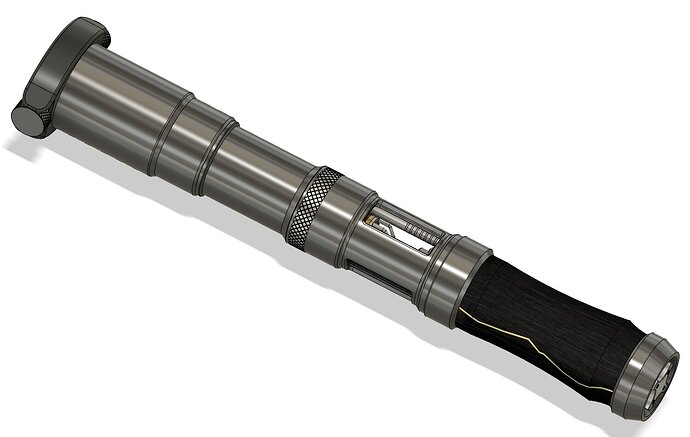IT BEGINS
This starts when I went to Disney with a friend to see what sabers they had on sale. Zero. Not a single one, not even for display. Really disappointing. While legacy sabers aren’t the best, some of the hilts are really nice for the price.
But that’s ok, I can make them a saber. And it’ll be better (neopixel/proffieboard). And full custom, completely from scratch. And it’ll be themed to their favorite character.
So I made a completely custom, from-scratch Iron Man themed lightsaber. And I got it done almost 1 year later to the day, about ~12 hours before I left for my trip!.
The pics
The parts
Electronics:
- proffieboard v2.2
- 18650 battery
- TCSS 28mm speaker
- GX16 4-pin connector
Blade
- ws2812b 144/m LED strip
- TCSS 1" thin wall (clear), diffuser
- packing foam & gift wrap
- GX16 4-pin connector
Hilt
- 1 1/4 sink extension pipe from home depot
- 3d printed exterior
- lots of sanding & paint
- single ws2812b accent for the button
- small 6mm momentary switches (x2)
Some odd choices
No set screw – I really dislike the idea of retention screws. If I’m traveling with the saber and have to assemble on the spot, no way I want to mess with a tiny set screw + allen wrench. I really like how the Disney sabers twist & lock, so I created my own version of that. You just insert the blade & twist it. Magnets (and friction) hold the blade from accidentally untwisting, and screw-heads keep the blade in place (think frankenstein’s neck bolts, which get captured into slots in the plastic).
The GX16 connector – I played with a lot of connectors (4mm bullets, XT60, XT30, MR30 3-pin). Bullets are nice and cheap, but very hard to make secure in a small 3d printed plastic base. I went with the GX16 which worked well. It’s nice to have a premade connector I can just drop in, but it’s also a little bulky and constraining on the design. Next saber will use (2x) XT30’s and I’ll try using epoxy to secure them.
No pogo pins – I love the idea of POGO pins & pcbs, but they’re fairly pricy. GX16 costs ~$1.25. A pogo set costs $15-20 (factoring in shipping), and there’s fewer places to get them. Plus, I needed 4 pins on the blade (more on that later).
Blade doubles as kill switch – This is why I needed 4 pins on the blade. The blade acts as the kill switch (or more aptly, the enable switch). All power flows through the blade back into the hilt, so when you remove the blade it also disconnects power. No secondary kill switch to forget. Works really well, and just requires one more (low-current) pin.
Removable chassis - I wanted the chassis to slide right out, no tools required. But since I’m not using pogo pins or spring contacts it had to be all in one; from the top physical connection to the blade, all the way to the bottom speaker. This made things really complicated, especially with buttons mounted on the chassis but pressed “through” the hilt.
Lessons learned
Last saber was designed in sketchup, and sketchup does not like fine small-scale CAD (lots of non-planar faces). This time I used a proper CAD (onshape)… HUGE DIFFERENCE! Worth the time learning it, I really couldn’t have done this in sketchup. I also tried openscad, but you really can’t do this in programming; you need some UI, there are some complex things going on here.
I also had to design each piece a few times over and over, mainly as I learned better strategies for modeling. But it was worth restarting each time, since the more you build on something the more the underlying flaws bite you.
The exterior design was really hard. It’s simpler to figure out “how do I get A to connect to B”. It’s much harder to figure out “How do I make this look cool & less stupid?” But I love the misc faux wiring panel on the back of the handle, it’s my favorite part.
The paint came out amazing. Kudos to “Frankly Built” on youtube, I used his recommendations for spray cans and it’s awesome.
The arc reactor button is my favorite part. It’s just so cool to have it glowing right in the middle, and very satisfying to press.
It was really hard to wire everything up. I tried hard to keep things clean and orderly, but there’s just too many bulky wires. I was using what I thought were 28AWG, but they were probably closer to 20-22 AWG which explains the difficulty. I just got some 30 AWG in, and those are TINY! Those would have helped a ton.
Next time
I’m going to design a minimal/modular chassis; the chassis itself will be contain just the battery/proffie/speaker. The buttons & accents will be permanently installed on the hilt, and I’ll use a multi-pin connector to connect the two. This means no crazy through-hilt button pushing, no restrictions on chassis size/shape/diameter. It can be much smaller and simpler. I avoided this last time since I didn’t want to have to design 2 completely separate connectors (blade → hilt → chassis), but I think it’s worth the effort. I’ll need ~7 pins, but that should be fine (probably an XT30 + duponts for the rest).
This also means the same chassis can fit multiple hilts. Currently the all-in-one chassis requires a saber of the exact same length, with buttons in the same spot. The modular chassis should work with any combo, even varying number of buttons/accents.
I used a clear TCSS blade + diffuser. It’s brighter than the milky blade, but less even (although it’s also badly packed… I was in a rush!). I’ll probably go with milky blade + diffuser next time.




